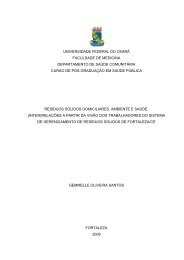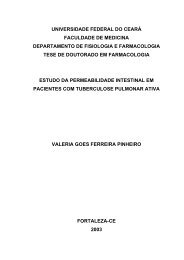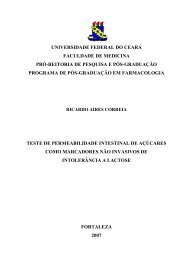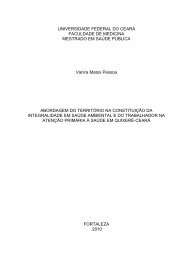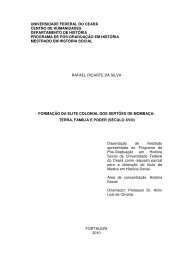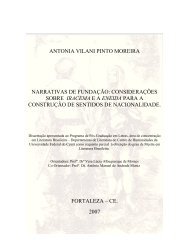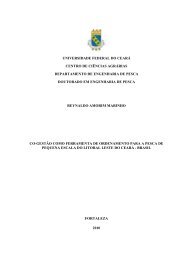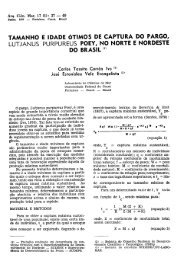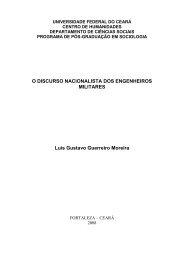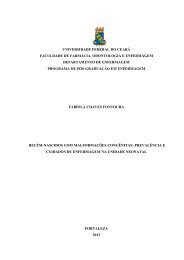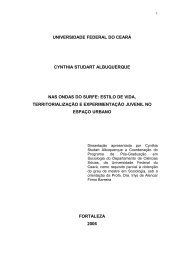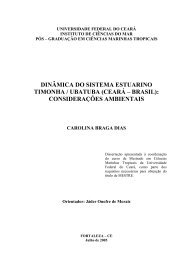Tungíase: doença negligenciada causando patologia grave
Tungíase: doença negligenciada causando patologia grave
Tungíase: doença negligenciada causando patologia grave
Create successful ePaper yourself
Turn your PDF publications into a flip-book with our unique Google optimized e-Paper software.
Heukelbach et al – Tungiasis in Alagoas State, Brazil<br />
The most common clinical signs in individuals<br />
with tungiasis were desquamation of skin and<br />
hyperkeratosis. Deformation of nails was also very<br />
common (Table 3). About 15% of cases showed<br />
signs of superinfection. Severe pathology, such as<br />
deep fissures, and difficulty walking was also<br />
common. Interestingly, 67% of the individuals<br />
stated that they felt the flea penetrating into the<br />
skin.<br />
Discussion<br />
Our data show that tungiasis is prevalent in the<br />
rural community under study, and that prevalence<br />
varies according to the season. Children were<br />
identified as a high-risk group. The prevalence of<br />
tungiasis encountered in Feliz Deserto (22% in the<br />
rainy season, 30% in the dry season) was<br />
impressively high, although considerably lower as<br />
compared to other studies in impoverished<br />
communities. For example, in population-based<br />
studies in rural Brazil and Nigeria, prevalences of<br />
51% and 45% were found [6,9]. In an urban slum<br />
in Brazil, prevalence in the peak dry season was<br />
as high as 54% [24]. Njeumi et al. (2002) reported<br />
about 50% of school children to be infested in<br />
different communities in Cameroon [14].<br />
The relatively low prevalence found in our<br />
study may have different reasons. Housing was<br />
much better than in the other impoverished<br />
communities studied: in Feliz Deserto all houses<br />
had access to piped water, and most had<br />
cemented floors. A sandy floor inside the house is<br />
known as a major risk factor for the presence of<br />
tungiasis and severity of infestation [21,22]. In<br />
Feliz Deserto, pigs were rare and not allowed to<br />
roam freely within the community - free-roaming<br />
pigs were common in a Nigerian community with a<br />
high prevalence and contributed to an important<br />
degree to transmission [22]. Since waste collection<br />
was performed daily, there was little waste littering<br />
the inhabited area, reducing the number of rats<br />
serving as an animal reservoir [25].<br />
In Feliz Deserto the most severely affected age<br />
groups were children < 15 years of age,<br />
irrespective of the season. This seems to be a<br />
characteristic finding pertaining to many endemic<br />
areas [4-6,8-10,26]. Tungiasis has to be<br />
considered mainly a disease of the childhood.<br />
The S-shaped age-specific distribution with<br />
peak prevalences in children and the elderly was<br />
less pronounced in Feliz Deserto than in other<br />
!<br />
"!#$%&'(!)&*&+,-.$/!0,1$(2.&3!"##$%!&'"()!"#"*"#+,<br />
endemic communities [6,9,15]. Particularly, the<br />
increase of prevalence in the elderly was less<br />
accentuated. However, when age-related<br />
prevalences were stratified into males and females<br />
a peculiar pattern emerged: whereas prevalence in<br />
females decreased constantly with increasing age,<br />
in males the S-shaped curve was very clear.<br />
The increased prevalence in the elderly male<br />
indicates that acquired immunity against T.<br />
penetrans is unlikely to develop. Re-increasing<br />
prevalences in elder male age groups are likely<br />
due to differences in exposure between men and<br />
women. In Feliz Deserto, adult men frequently<br />
work outside the endemic area during the day and<br />
commonly use closed shoes during work. In<br />
contrast, elderly males are usually retired, stay the<br />
whole day in the community, walk barefooted, and<br />
put their bare feet on the ground when sitting and<br />
chatting. Alternatively, they may care less about<br />
penetrated fleas, while elder women tend to take<br />
out sand fleas as soon as they perceive a<br />
penetrated flea.<br />
In our study, the prevalence of tungiasis was<br />
slightly higher in the male sex in both surveys.<br />
Apparently, the pattern of occurrence of tungiasis<br />
in males and females differs from community to<br />
community. For example, Carvalho et al. (2003)<br />
observed significantly more females than males<br />
affected in a resource-poor community in South<br />
Brazil [5]. No difference in the prevalence between<br />
males and females was found in a rural community<br />
in Lagos State in Nigeria, and in a fishing<br />
community in Ceará State, Brazil [6,9]. In contrast,<br />
authors from Brazil, Trinidad, and Nigeria found<br />
that males were predominantly affected<br />
[4,8,10,26]. In a longitudinal study in an urban<br />
slum, tungiasis was consistently more common in<br />
the male sex during a study period of 12 months<br />
[24].<br />
The parasite load and the maximum number of<br />
lesions found in Feliz Deserto were rather low<br />
(mean < 4 in both surveys). In a fishing community<br />
in Brazil, the mean parasite load was 8.9 [9], in a<br />
rural community in Nigeria 12.3 [6], in an urban<br />
slum in Ceará State 7.8 [10], and in several<br />
communities in Trinidad 8.0 [4]. In the latter two<br />
studies, prevalence was comparable to Feliz<br />
Deserto with 34% and 21%, respectively. Thus the<br />
hypothesis formulated previously that prevalence<br />
and intensity of infestation are positively related<br />
did not hold true for Feliz Deserto [9]. As it is<br />
206



